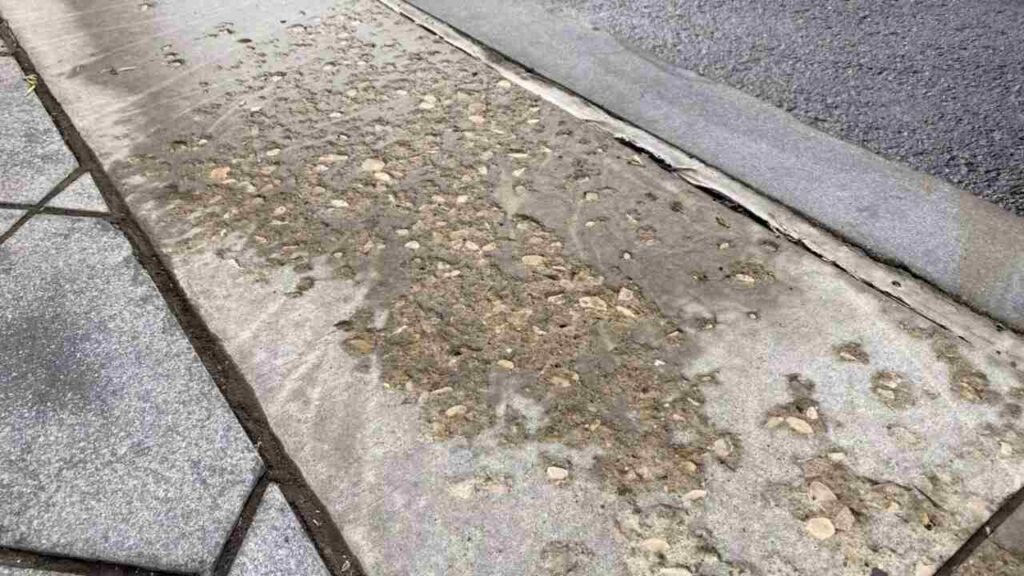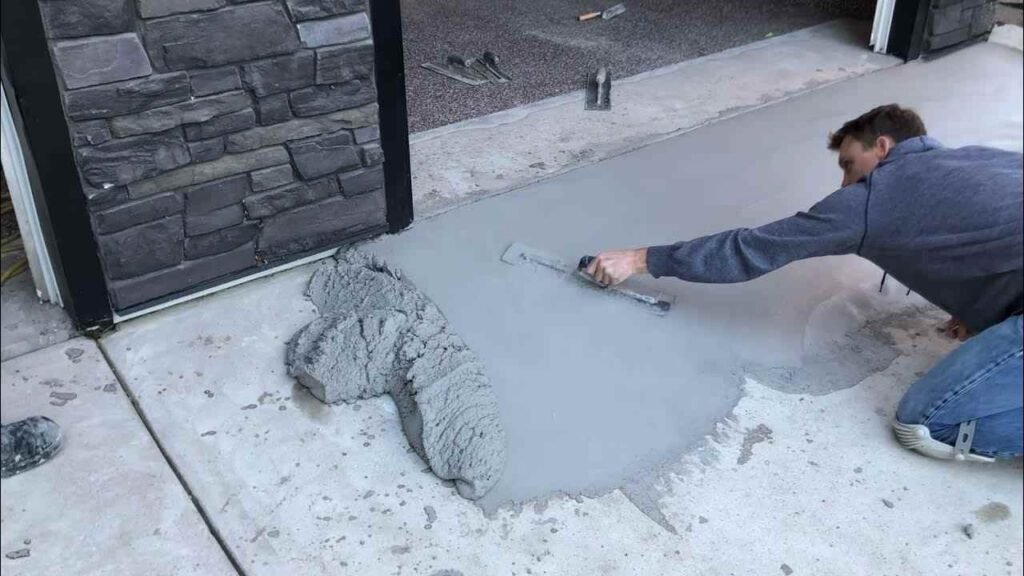Concrete driveways are a popular choice for homeowners because of their durability and clean look, but they aren’t without their issues. Over time, you might notice cracks forming, stains appearing, or sections sinking due to various factors like weather, poor installation, or simply aging. Cracks are perhaps the most common problem, and if left unattended, they can worsen over time. Stains from oil, grease, or even leaves can dull the appearance of your driveway, while sinking sections may create trip hazards and drainage issues. In this guide and with the help of Evergreen Landscaping of Cincinnati, we will explore these common issues in more detail and provide practical solutions to help you repair and maintain your concrete driveway, keeping it in top shape for years to come.

Luckily, many of these problems can be fixed with the right tools and techniques. Driveway services can also be a great resource to help with more complicated repairs. Knowing how to address these common issues can help keep your driveway looking great and lasting longer. Regular maintenance, like sealing cracks and removing stains promptly, can prevent further damage. Plus, proper care and professional driveway services will not only enhance curb appeal but also save you from costly repairs down the road.
Common Causes of Concrete Driveway Damage
Concrete driveways, while durable, require regular maintenance to prevent damage caused by several factors. Weather is one of the primary causes, with freezing and thawing cycles causing expansion and contraction in the concrete, leading to cracks. Poor installation practices, such as inadequate base preparation or improper concrete mix, can also result in weakened areas that are more susceptible to damage. Heavy loads, like large vehicles or construction equipment, may place excessive pressure on the driveway, leading to cracking or sinking. Additionally, tree roots growing underneath the surface can push up the concrete, causing unevenness or even breaks. Consistent maintenance is essential to address and prevent these issues, ultimately extending the lifespan of your driveway.
Identifying Cracks: Types and Causes
Cracks in concrete driveways are a common issue, but not all cracks are the same. Hairline cracks, often caused by shrinkage during the curing process, are typically cosmetic and don’t pose structural concerns, but regular sealing can prevent them from worsening. Larger cracks, however, can indicate underlying problems like poor soil compaction, freeze-thaw cycles, or heavy vehicle loads, requiring more extensive repairs. Settlement cracks occur when the ground beneath the concrete shifts, causing the surface to sink and crack, which may need attention from a professional. Expansion cracks happen when the concrete expands due to heat without enough room to accommodate the movement; proper maintenance includes ensuring adequate joint spacing and sealing. Identifying the type and cause of the crack is critical in determining the appropriate repair method and maintaining the driveway’s integrity over time.
How to Repair Small and Large Cracks in Concrete Driveways
Repairing cracks in your concrete driveway depends on their size and severity. Small hairline cracks can be easily filled using a concrete crack filler or sealant. After thoroughly cleaning the crack to remove debris, you simply apply the filler, smoothing it out with a putty knife. For larger cracks, a more robust solution is needed. First, clean the area and widen the crack slightly with a chisel to create a better bonding surface. Then, use a concrete patching compound, pressing it into the crack and leveling it with a trowel. After it sets, apply a sealant to protect the area from future damage, ensuring a long-lasting repair. In areas with stringent erosion control requirements, installing driveways may involve additional considerations, such as enhanced drainage systems and erosion-resistant materials, to comply with local regulations and prevent future issues.

Preventing Future Cracks: Maintenance Tips
Preventing cracks in your concrete driveway requires consistent maintenance and proactive care. One of the most effective strategies is sealing your driveway regularly, which helps protect it from moisture infiltration, freeze-thaw cycles, and other environmental stresses. Controlling water runoff by ensuring proper drainage is another crucial step to avoid erosion and pooling, which can weaken the driveway’s base. Avoid placing heavy vehicles or equipment on the driveway for extended periods, as this can cause stress fractures. Keep tree roots in check by planting trees a safe distance away from the driveway. Regularly inspect your driveway for small cracks or signs of wear and repair them promptly to prevent further deterioration.
Removing Stubborn Stains from Concrete Driveways
Stains can mar the appearance of a concrete driveway, but with the right techniques, they can be removed effectively. Oil and grease stains are common and can be addressed with a mixture of baking soda and dish soap or a commercial concrete cleaner. Apply the cleaner, scrub with a stiff brush, and rinse with water. Rust stains, often caused by metal objects or fertilizer runoff, may require a specialty rust remover or a solution of vinegar and water. Leaf stains, which result from decomposing organic matter, can be lifted using a pressure washer or a mix of bleach and water. Regularly cleaning your driveway and addressing stains promptly will keep it looking its best.
Solutions for Sinking or Uneven Concrete Sections
Sinking or uneven sections in a concrete driveway can create not only an eyesore but also potential hazards. This issue is often caused by poor soil compaction or erosion beneath the driveway. To fix this, one option is “slab jacking,” where a mixture of grout is pumped beneath the sunken slab to raise it back into place. For more severe sinking, replacing the affected area may be necessary. In cases of minor sinking, resurfacing the concrete might be sufficient to level the driveway. It’s essential to address sinking early to prevent further damage, such as cracks or breaks in the concrete, and ensure the driveway remains safe and functional.
The Importance of Proper Drainage for Driveway Longevity
Proper drainage is crucial for the longevity of your concrete driveway. When water pools on the surface or seeps into cracks, it can lead to erosion and weaken the foundation beneath the driveway, causing cracks, sinking, or even structural failure. Installing a well-designed drainage system, such as French drains or proper grading, can help direct water away from the driveway, preventing damage. Regularly clearing gutters and downspouts also ensures that water isn’t draining onto the driveway. Additionally, sealing the concrete helps minimize water penetration. By maintaining good drainage, you can significantly reduce the risk of damage, extending the life of your driveway and preventing costly repairs.
How Weather Affects Your Concrete Driveway
Weather plays a significant role in the condition of your concrete driveway. In colder climates, the freeze-thaw cycle can cause water trapped in small cracks to expand, leading to larger cracks and damage over time. Hot temperatures can also have an impact, causing the concrete to expand and potentially crack if there’s not enough room for movement. Additionally, rain and moisture can seep into the surface, weakening the concrete’s structure, especially if the driveway isn’t properly sealed. Protecting your driveway with regular sealing and using weather-appropriate materials during installation can help mitigate the effects of extreme weather conditions and prolong its lifespan.
Choosing the Right Tools and Materials for Driveway Repairs
Choosing the right tools and materials is essential for effective concrete driveway repairs. For crack repair, you’ll need a chisel, wire brush, and concrete filler or patching compound. A trowel is useful for smoothing out the patch, while a caulking gun may be needed for applying sealants. If you’re dealing with stains, a stiff brush and the appropriate cleaners, such as degreasers or rust removers, are vital. For larger repairs, a concrete saw or grinder might be necessary. Additionally, ensure you select high-quality concrete patching materials designed for outdoor use, as they are more durable and better suited for withstanding weather conditions and heavy loads.
The Role of Professional Driveway Services in Maintenance and Repair
While many driveway issues can be tackled with DIY solutions, professional driveway services play a vital role in maintaining and repairing more significant problems. Professionals have the expertise and specialized equipment to handle complex repairs, such as slab jacking for sinking sections, complete resurfacing, or dealing with extensive cracking. They can also offer preventive services, like sealing, that extend the life of the driveway. By hiring professionals, you ensure that the job is done correctly, minimizing the risk of recurring problems and costly future repairs. Investing in professional services can be a smart move, particularly for larger projects or ongoing maintenance needs.
Sealing Your Concrete Driveway for Long-Term Protection
Sealing your concrete driveway is one of the best ways to protect it from long-term damage. Sealers act as a barrier against water, oil, chemicals, and other contaminants that can seep into the concrete and cause cracking, staining, or erosion. A quality sealer also helps prevent damage from freeze-thaw cycles by reducing water absorption. To apply, clean the driveway thoroughly and allow it to dry before spreading the sealer evenly across the surface with a roller or sprayer. Regular resealing, typically every 2-3 years depending on wear and weather conditions, will keep your driveway looking fresh and extend its lifespan by preventing surface damage.
Conclusion
Maintaining a concrete driveway requires attention to detail and regular upkeep, but the effort pays off by extending its life and preserving its appearance. Whether addressing small cracks, removing stains, or tackling more significant issues like sinking sections, proper care can prevent minor problems from turning into costly repairs. Regular sealing, prompt repairs, and ensuring proper drainage all play a critical role in protecting your driveway from weather, wear, and damage. While many tasks can be handled with DIY solutions, professional driveway services offer the expertise needed for more complex repairs and preventive maintenance. By taking a proactive approach to driveway care, you can keep your concrete driveway safe, functional, and looking great for years to come.
FAQs
What causes cracks in concrete driveways?
Cracks are often caused by weather conditions, poor installation, heavy loads, or ground movement beneath the concrete.
How often should I seal my concrete driveway?
Sealing should typically be done every 2-3 years to protect against moisture, stains, and wear from weather conditions.
Can I fix small cracks in my driveway myself?
Yes, small cracks can often be repaired using concrete crack filler or sealant with simple tools like a trowel or caulking gun.
How can I remove oil stains from my concrete driveway?
Oil stains can be removed using baking soda and dish soap, or a commercial concrete cleaner, along with scrubbing and rinsing.
When should I consider hiring professional driveway services?
Professional services are recommended for complex repairs like slab jacking, resurfacing, or when DIY solutions aren’t sufficient.
